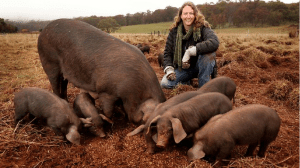This is the text of the speech delivered by AFSA National Coordinator Dr Nick Rose to the sell-out audience of 200 people, at the premiere of the Fair Food documentary at the National Gallery of Victoria on Tuesday 2nd December, 2014.
Why did we make this film? Because the Food System is broken.
Why is it broken?
Because we have fully applied the technologies and the mindset of industrialisation to food and farming. And because we have combined industrialisation with the logic and the imperative of endlessly increasing production, regardless of the consequences.
What does that mean? It means we have over-exploited our land, degraded our soils, and damaged our river systems. It means we have one of the highest rates of deforestation, biodiversity loss and species extinction on the planet. It means, globally, that the food system contributes as much as 50% of all greenhouse gas emissions.
It means that we have a supermarket duopoly which controls 70-80 percent of the grocery market, forcing farmers and food processors into price-taker relationships. 100 years ago farmers received 90 cents of every dollar’s worth of food they produced; today it’s around 10 cents.
Farming has become de-valued in our highly urbanized culture; and not just economically. So it’s shocking, but not surprising, that 7 farmers leave the land every day, and that rates of suicide and depression amongst farmers are twice the national average.
Our industrialised food system produces too much food of the wrong type. So we’re subjected to an endless barrage of advertising, urging us to buy food products laced with excess sugars and salt. Dietary-related diseases are already amongst the biggest public health issues we face.
Our food system is not merely broken. It’s killing us, and ruining any chance that future generations have for a decent and liveable future. Yet the industrialised food system persists, and is expanding. Why? Because there are very powerful economic and financial interests that make a lot of money from the status quo. Because we are so disconnected from our food system. Because food is apparently abundant and cheap, and because we don’t join these dots.
We made this film, and we formed the Australian Food Sovereignty Alliance, because we can no longer tolerate this state of affairs. Because it’s no longer enough just to talk or think in terms of reforms. We need a transformation; we need a revolution.
And that revolution begins in our own minds, in our hearts, in our consciousness. We need to see ourselves as part of the story of the Great Work, the work that matters. As philosopher Thomas Berry puts it:
The Great Work now, as we move into a new millennium, is to carry out the transition from a period of human devastation of the Earth to a period when humans would be present to the planet in a mutually beneficial manner.
This is the challenge to every one of you here in this room. This is the choice facing every one of us alive today. Do we continue to allow our culture and our society to become ever-more destructive, and ever-more violent? Do we choose to remain in a paradigm which says that the Earth, and indeed ourselves, only exist for endless exploitation so that a tiny fraction of humanity can enjoy obscene levels of wealth?
Or do we choose to be part of the great challenge of our times – the greatest challenge of all times? To create a shared vision of a wonderful, bountiful world, where there is no hunger and no poverty; where soils are thriving, rivers are healthy and forests are abundant; where animals roam freely; and where all of us are healthy and flourishing.
Do we choose to see ourselves as victims of processes and powers beyond our control, and simply walk away and do nothing, resigned to our fate? Or do we choose to see ourselves as subjects and shapers of our own history, as creators and narrators of our own story, as powerful beings with the capacity to effect great changes?
Because I’m here to tell you, that’s who we are. We are powerful.
We made this film because these are messages that need to be heard. This is the story that needs to be told; that we need to tell ourselves, and each other. We made this film because we know that there are women and men all over this state, and all around this country, who have embraced this new paradigm, who are blazing a trail towards the decent, fair and liveable future that all of us want.
We’re here tonight to recognize and celebrate them.
They are our Fair Food Pioneers.
And this is the story of Fair Food.





















